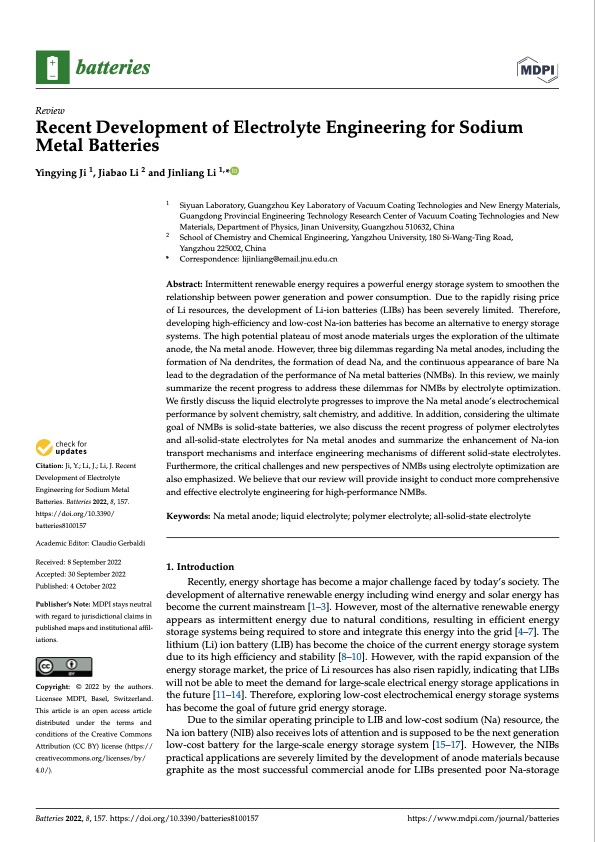
PDF Publication Title:
Text from PDF Page: 001
batteries Review Recent Development of Electrolyte Engineering for Sodium Metal Batteries Yingying Ji 1, Jiabao Li 2 and Jinliang Li 1,* 1 * Correspondence: lijinliang@email.jnu.edu.cn Abstract: Intermittent renewable energy requires a powerful energy storage system to smoothen the relationship between power generation and power consumption. Due to the rapidly rising price of Li resources, the development of Li-ion batteries (LIBs) has been severely limited. Therefore, developing high-efficiency and low-cost Na-ion batteries has become an alternative to energy storage systems. The high potential plateau of most anode materials urges the exploration of the ultimate anode, the Na metal anode. However, three big dilemmas regarding Na metal anodes, including the formation of Na dendrites, the formation of dead Na, and the continuous appearance of bare Na lead to the degradation of the performance of Na metal batteries (NMBs). In this review, we mainly summarize the recent progress to address these dilemmas for NMBs by electrolyte optimization. We firstly discuss the liquid electrolyte progresses to improve the Na metal anode’s electrochemical performance by solvent chemistry, salt chemistry, and additive. In addition, considering the ultimate goal of NMBs is solid-state batteries, we also discuss the recent progress of polymer electrolytes and all-solid-state electrolytes for Na metal anodes and summarize the enhancement of Na-ion transport mechanisms and interface engineering mechanisms of different solid-state electrolytes. Furthermore, the critical challenges and new perspectives of NMBs using electrolyte optimization are also emphasized. We believe that our review will provide insight to conduct more comprehensive and effective electrolyte engineering for high-performance NMBs. Keywords: Na metal anode; liquid electrolyte; polymer electrolyte; all-solid-state electrolyte 1. Introduction Recently, energy shortage has become a major challenge faced by today’s society. The development of alternative renewable energy including wind energy and solar energy has become the current mainstream [1–3]. However, most of the alternative renewable energy appears as intermittent energy due to natural conditions, resulting in efficient energy storage systems being required to store and integrate this energy into the grid [4–7]. The lithium (Li) ion battery (LIB) has become the choice of the current energy storage system due to its high efficiency and stability [8–10]. However, with the rapid expansion of the energy storage market, the price of Li resources has also risen rapidly, indicating that LIBs will not be able to meet the demand for large-scale electrical energy storage applications in the future [11–14]. Therefore, exploring low-cost electrochemical energy storage systems has become the goal of future grid energy storage. Due to the similar operating principle to LIB and low-cost sodium (Na) resource, the Na ion battery (NIB) also receives lots of attention and is supposed to be the next generation low-cost battery for the large-scale energy storage system [15–17]. However, the NIBs practical applications are severely limited by the development of anode materials because graphite as the most successful commercial anode for LIBs presented poor Na-storage Siyuan Laboratory, Guangzhou Key Laboratory of Vacuum Coating Technologies and New Energy Materials, Guangdong Provincial Engineering Technology Research Center of Vacuum Coating Technologies and New Materials, Department of Physics, Jinan University, Guangzhou 510632, China School of Chemistry and Chemical Engineering, Yangzhou University, 180 Si-Wang-Ting Road, 2 Yangzhou 225002, China Citation: Ji, Y.; Li, J.; Li, J. Recent Development of Electrolyte Engineering for Sodium Metal Batteries. Batteries 2022, 8, 157. https://doi.org/10.3390/ batteries8100157 Academic Editor: Claudio Gerbaldi Received: 8 September 2022 Accepted: 30 September 2022 Published: 4 October 2022 Publisher’s Note: MDPI stays neutral with regard to jurisdictional claims in published maps and institutional affil- iations. Copyright: © 2022 by the authors. Licensee MDPI, Basel, Switzerland. This article is an open access article distributed under the terms and conditions of the Creative Commons Attribution (CC BY) license (https:// creativecommons.org/licenses/by/ 4.0/). Batteries 2022, 8, 157. https://doi.org/10.3390/batteries8100157 https://www.mdpi.com/journal/batteriesPDF Image | Recent Development for Sodium Metal Batteries

PDF Search Title:
Recent Development for Sodium Metal BatteriesOriginal File Name Searched:
batteries-08-00157-v2.pdfDIY PDF Search: Google It | Yahoo | Bing
Salgenx Redox Flow Battery Technology: Salt water flow battery technology with low cost and great energy density that can be used for power storage and thermal storage. Let us de-risk your production using our license. Our aqueous flow battery is less cost than Tesla Megapack and available faster. Redox flow battery. No membrane needed like with Vanadium, or Bromine. Salgenx flow battery
| CONTACT TEL: 608-238-6001 Email: greg@salgenx.com | RSS | AMP |